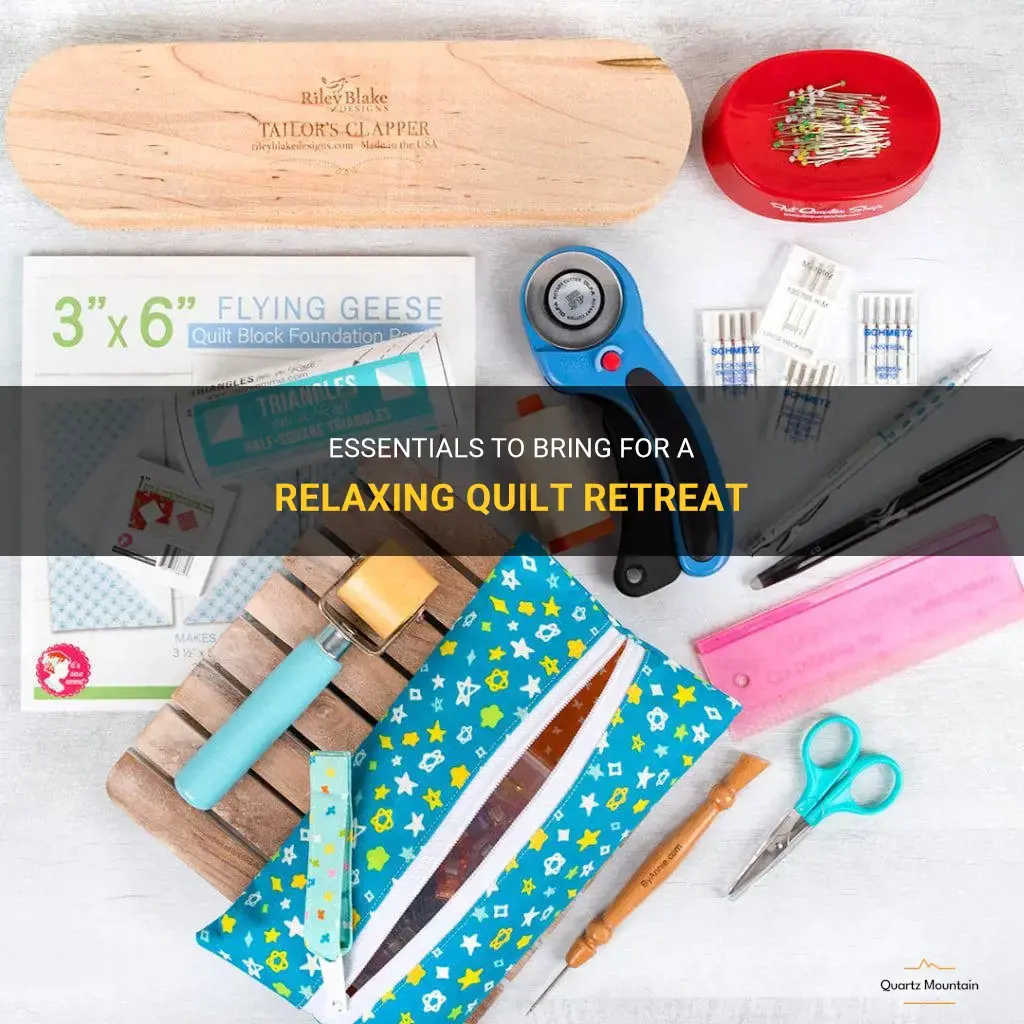
Are you a fan of quilting? Do you dream of escaping to a peaceful retreat where you can indulge in your favorite hobby without any distractions? Well, look no further! A quilt retreat is the perfect getaway for anyone seeking relaxation and creativity. But before you embark on this adventure, it's important to pack the essentials to ensure a smooth and enjoyable experience. From your trusty sewing machine to cozy quilting supplies, we've got you covered. So sit back, relax, and let us guide you on what to bring for a truly unforgettable quilt retreat.
What You'll Learn
- What are some essential items to pack for a quilt retreat?
- Are there any specific types of quilting tools or supplies that are recommended for a quilt retreat?
- Is there anything I should include in my packing list for comfort or relaxation during the quilt retreat?
- How many quilting projects should I plan to bring to a quilt retreat?
- Are there any clothing or personal items that I should bring specifically for a quilt retreat?

What are some essential items to pack for a quilt retreat?
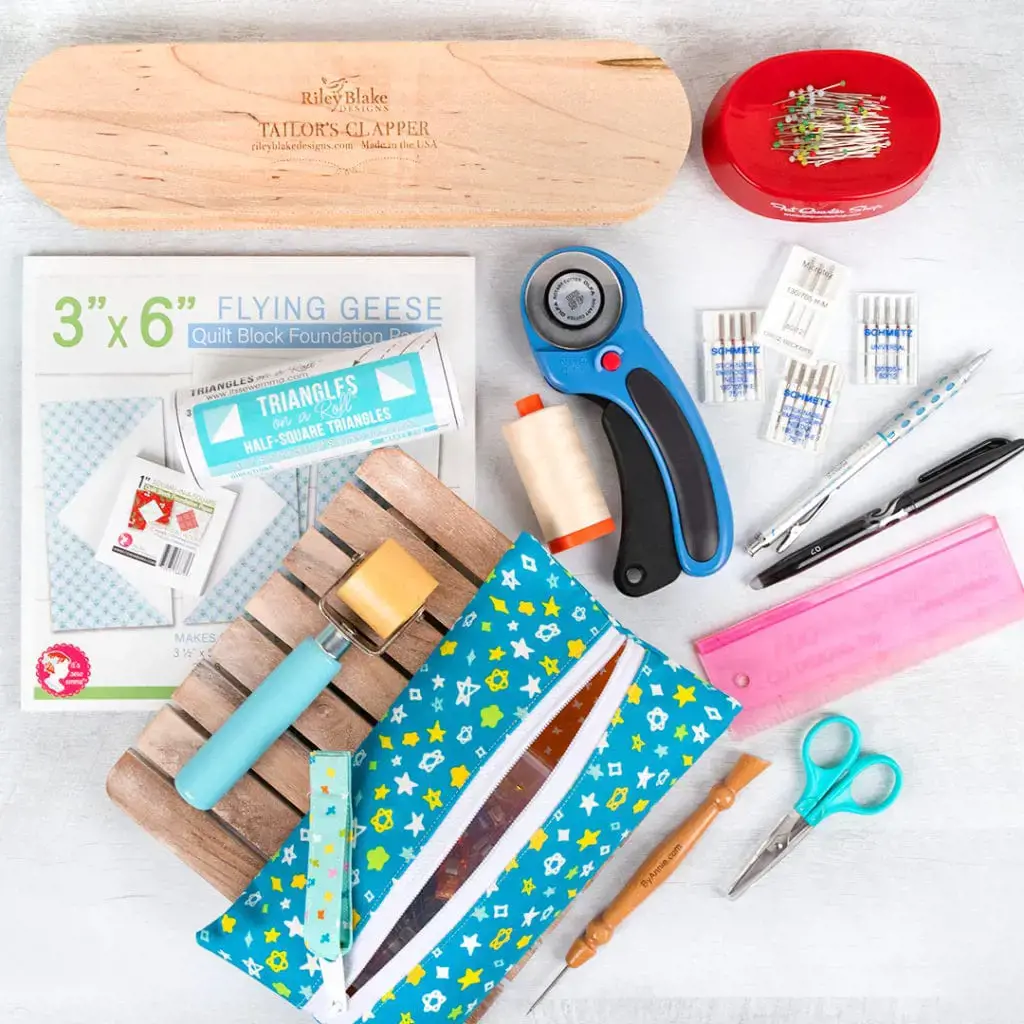
A quilt retreat is a wonderful opportunity for quilting enthusiasts to come together, learn new techniques, and work on their projects in a peaceful and creative environment. Whether you are a seasoned quilter or a beginner, packing the right items for a quilt retreat is essential to ensure a productive and enjoyable experience. Here are some essential items that you should consider packing for your next quilt retreat:
- Sewing Machine: Your sewing machine is the most important tool for quilting, so don't forget to pack it along with any necessary accessories such as foot pedal, power cord, and extra bobbins. Make sure your machine is in good working condition and consider bringing a sewing machine cover or case to protect it during transportation.
- Quilting Supplies: Pack all the essential quilting supplies, including fabric, thread, needles, pins, scissors, rotary cutter, cutting mat, rulers, and marking tools. Having a variety of fabric choices and colors will allow you to work on different quilting projects and experiment with different techniques.
- Notions and Tools: In addition to basic quilting supplies, consider packing some extra notions and tools that can enhance your quilting experience. These may include thimbles, fabric glue, needle threader, seam ripper, quilting gloves, or specialty rulers for specific quilt patterns.
- Iron and Ironing Board: A portable iron and ironing board are essential for achieving professional-looking quilt blocks. They help in pressing seams, removing wrinkles, and preparing fabric pieces for piecing. Consider investing in a compact and lightweight travel iron and a small tabletop ironing board that can easily fit into your luggage.
- Lighting and Magnification: Good lighting plays a crucial role in ensuring accurate piecing and enhancing the visibility of your stitches. Pack a portable LED light or a task light that can be easily attached to your sewing machine or work area. If you require magnification for detailed work, consider bringing a small magnifying lamp or a pair of magnifying glasses.
- Comfortable Seating: Quilting retreats often involve long hours of sewing, so make sure to pack a comfortable chair with proper back support. Consider bringing a cushion, pillow, or a padded seat to prevent fatigue and strain on your back.
- Storage and Organization: To keep your quilting supplies organized and easily accessible, pack storage containers, ziplock bags, or small pouches for sorting and storing your sewing notions, fabric pieces, and patterns. Labeling your storage containers can further streamline your quilting process.
- Personal Care Items: Don't forget to pack personal care items such as hand sanitizer, tissues, lip balm, and lotion to keep yourself clean and refreshed during the retreat. Additionally, consider bringing a water bottle and snacks to stay hydrated and energized throughout the day.
- Comfortable Clothing: Quilting retreats can be casual and relaxed, so pack comfortable clothing that allows freedom of movement. Layering your clothes is advisable as quilting rooms can vary in temperature.
- Inspiration and Entertainment: Bring along books, magazines, or patterns for inspiration during the retreat. Consider packing a small portable speaker or headphones to listen to music or audiobooks while quilting. Some retreats may also provide social activities or leisure amenities, so check with the organizers beforehand to see if you need to pack any leisure items.
Overall, packing the right items for a quilt retreat can make a significant difference in your quilting experience. By having all the essential tools, supplies, and personal items, you can focus on your projects and make the most out of the retreat. Remember to check the specific requirements or recommendations of the retreat organizers, as they may have additional suggestions tailored to the event. Happy quilting!
Essential Items to Pack for a Northern California Fall Weekend
You may want to see also

Are there any specific types of quilting tools or supplies that are recommended for a quilt retreat?
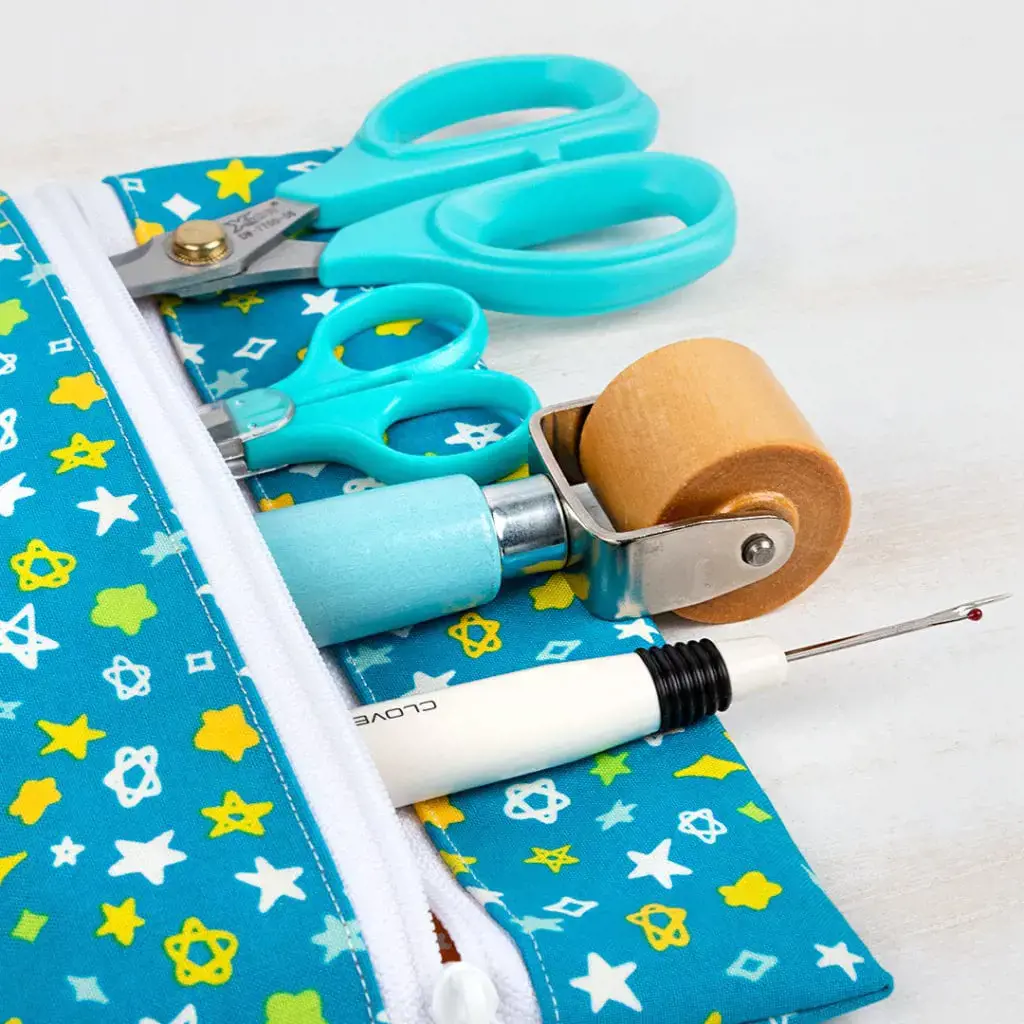
When attending a quilt retreat, it is important to come prepared with the necessary tools and supplies to make the most of your quilting experience. While each quilter may have their own preferences, there are a few specific types of quilting tools and supplies that are highly recommended for a quilt retreat. These items will help you stay organized, efficient, and ensure that you can create beautiful, high-quality quilts.
- Sewing Machine: The most essential tool for quilting is a sewing machine. It is recommended to bring a portable sewing machine that is easy to transport and set up. Make sure to bring all the necessary accessories for your machine, such as extra needles, bobbins, and thread.
- Cutting Tools: Accurate cutting is crucial for quilting, so it is important to bring a variety of cutting tools. A rotary cutter with a sharp blade is a must-have for cutting fabric quickly and accurately. Additionally, bring different sizes of quilting rulers to help with measuring and cutting fabric pieces. Don't forget to also bring a cutting mat to protect your working surface.
- Needles and Pins: Having a variety of hand sewing needles and pins is essential for quilting. Needles with different sizes and lengths are useful for different quilting techniques, such as hand piecing or hand quilting. Straight pins are useful for holding fabric pieces together, while quilting pins are longer and thicker, ideal for basting or holding multiple layers of fabric in place.
- Thread: High-quality thread is important for quilting to ensure the durability and longevity of your stitches. It is recommended to bring a variety of thread colors and weights to match your fabric and achieve different effects. Cotton thread is often preferred for quilting due to its strength and low lint.
- Scissors: Sharp, precision scissors are a must-have for any quilter. It is recommended to bring both fabric scissors and smaller scissors for cutting threads and trimming fabric pieces. Having a pair of small, sharp scissors will make the process of trimming and snipping threads much easier and neater.
- Marking Tools: Marking tools are necessary for transferring patterns, designs, or measurements onto fabric. Fabric markers, disappearing ink pens, or water-soluble pencils are commonly used for marking quilting lines, shapes, or quilting motifs. Test these markers on a scrap fabric before using them on your actual quilt to ensure they won't leave any permanent marks.
- Seam Ripper: Mistakes happen, even to experienced quilters. A seam ripper is a small tool with a pointy end that helps to remove stitches without damaging the fabric. It can save you a lot of frustration and time when correcting any quilting errors.
- Storage and Organization: To stay organized during a quilt retreat, invest in storage solutions like a sewing machine bag, thread organizer, or tool caddy. These items will help keep your tools and supplies easily accessible and prevent them from getting lost or damaged.
Remember, these are just some of the recommended quilting tools and supplies to bring to a quilt retreat. Each quilter may have their own preferences and specific needs. It is always a good idea to check with the retreat organizers for any additional recommendations or requirements to ensure a successful and enjoyable quilting experience.
The Ultimate Guide to Packing Food for Train Journeys: Tips and Ideas
You may want to see also

Is there anything I should include in my packing list for comfort or relaxation during the quilt retreat?
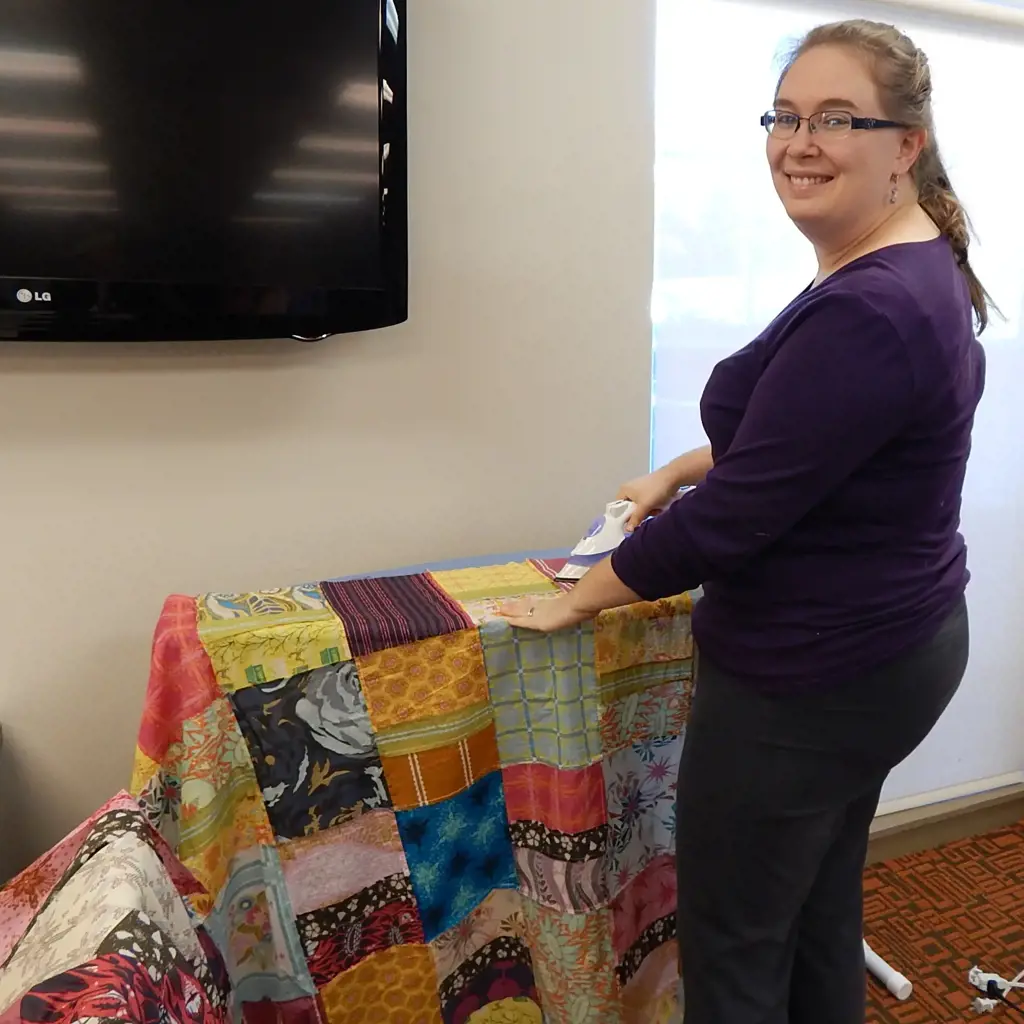
When preparing for a quilt retreat, it is essential to pack items that will contribute to your comfort and relaxation during your stay. Creating a quilt can be a time-consuming and mentally demanding process, so having the right supplies and environment is key to making the most of your experience. Here are some essential items that you should include in your packing list for maximum comfort and relaxation during your quilt retreat.
- Comfortable Clothing: Pack comfortable and loose clothing that allows for easy movement. You will be spending a significant amount of time sitting and working on your quilt, so choose clothes that won't restrict your movement or cause discomfort. Opt for breathable fabrics that will keep you cool, as quilting can sometimes generate heat.
- Ergonomic Tools: Quilting can put strain on your hands and wrists, especially if you're working for long periods. Invest in ergonomic tools such as rotary cutters with soft grips and ergonomic thimbles to minimize discomfort and prevent potential injuries.
- Supportive Chair: Since you'll be spending a lot of time seated, it's crucial to have a supportive and comfortable chair. Look for a chair with good lumbar support and adjustable height to ensure proper posture and prevent any back pain or discomfort.
- Cutting Mat and Ruler: A good quality cutting mat and ruler are essential for accurate cutting during the quilting process. Be sure to bring a large enough cutting mat to accommodate your projects, and choose a ruler with clear markings for precise measurements.
- Portable Ironing Board and Iron: A portable ironing board and iron are indispensable for quilting. They allow you to press seams and fabric as you work, ensuring your quilt pieces come together neatly. Look for a lightweight and compact iron and ironing board that can be easily transported to your retreat location.
- Task Lighting: Adequate lighting is crucial for accurate quilting and preventing eye strain. Bring a portable task light with adjustable brightness to ensure you can clearly see your work at all times.
- Comfortable Bedding: If you're staying overnight at the retreat location, make sure to bring your own comfortable bedding. A good-quality pillow, soft sheets, and a cozy blanket can make a significant difference in the quality of your sleep and overall comfort during your stay.
- Relaxing Music or Audiobooks: Create a calm and relaxed atmosphere by bringing your favorite music or audiobooks. Music and soothing sounds can help you stay focused and create a serene environment for your quilting sessions.
- Snacks and Drinks: Make sure to pack some healthy snacks and drinks to keep you energized throughout the day. Nuts, fruits, granola bars, and water bottles are great options to have on hand and keep you fueled during your quilting sessions.
- Leisure Activities: Take breaks from quilting and engage in leisure activities to relax and recharge. Bring along puzzles, coloring books, or any other hobby that you enjoy. Taking breaks to do something different can enhance your overall creativity and make the retreat more enjoyable.
In conclusion, packing the right items for your quilt retreat can significantly contribute to your comfort and relaxation. By including these essentials in your packing list, you'll create an environment that promotes a positive quilting experience from start to finish. Remember, the goal of the retreat is to enjoy the process, connect with fellow quilters, and create beautiful quilts. So, make sure to prioritize your comfort and relaxation during your quilt retreat.
Essential Packing Guide for Cruise Ship Jobs
You may want to see also

How many quilting projects should I plan to bring to a quilt retreat?
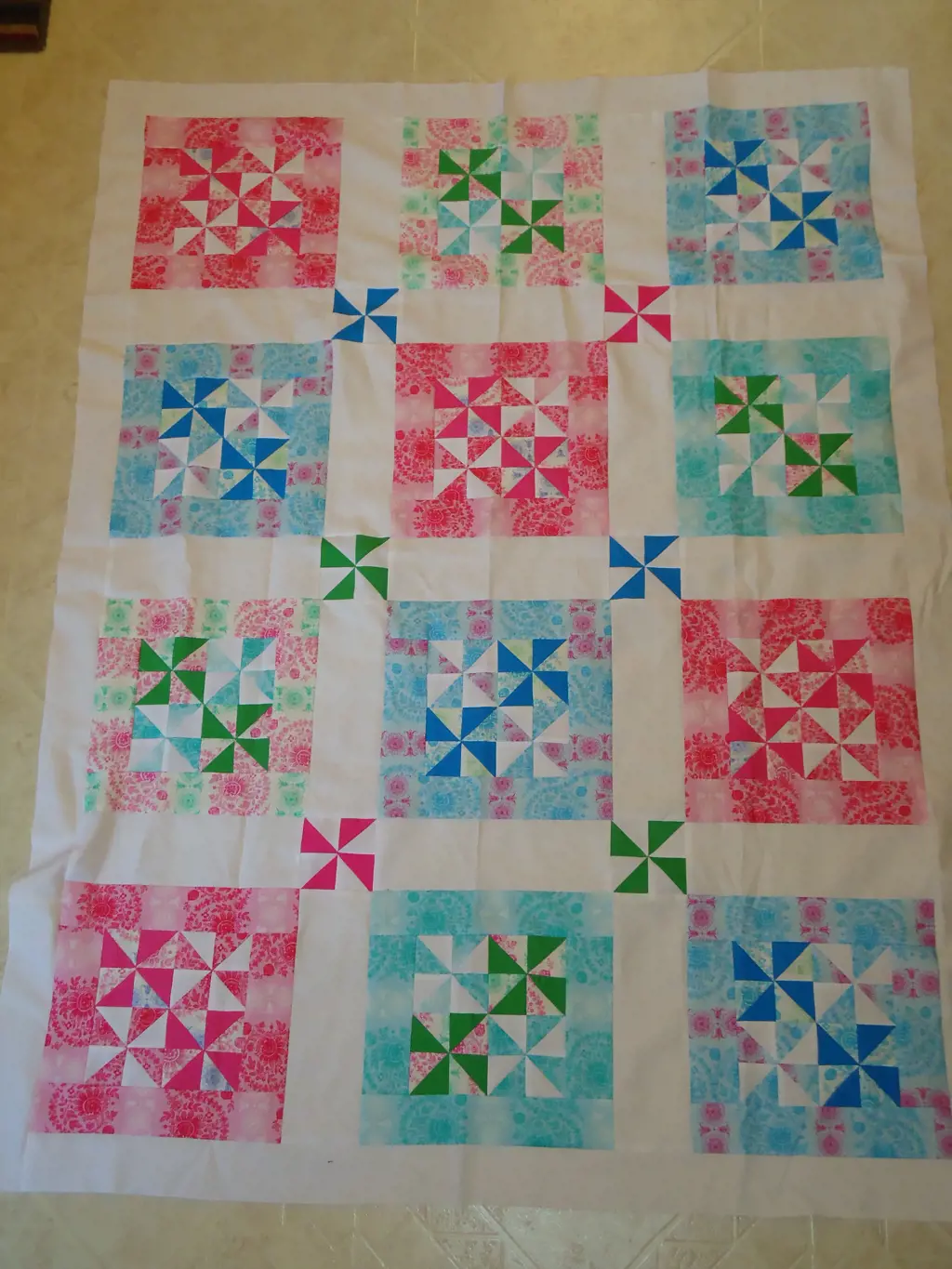
If you're planning to attend a quilt retreat, you may be wondering how many quilting projects you should bring along. Whether you're a seasoned quilter or a beginner, planning the right number of projects can help ensure you make the most of your time at the retreat. Here are some factors to consider when deciding how many quilting projects to bring.
- Retreat Duration: The duration of the retreat is an important factor to consider when deciding how many projects to pack. If you're attending a weekend retreat, you may not have as much time as you would at a week-long retreat. Plan accordingly and consider bringing fewer projects if you have less time.
- Skill Level: Your skill level is another consideration when thinking about how many projects to bring. If you're a beginner, you may want to start with one or two smaller projects that you can complete during the retreat. As you gain more experience, you can bring more complex or larger projects that may take longer to finish.
- Project Types: Consider the types of projects you'll be working on at the retreat. If you're planning to quilt large bed-sized quilts, you may not be able to complete as many compared to if you were working on smaller projects like baby quilts or table runners. Take into account the size and complexity of each project when making your decision.
- Time Management: It's important to be realistic about how much time you'll have to work on your projects during the retreat. Take into account other activities, such as workshops or socializing, that may take up time. If you're attending a retreat with a packed schedule, it's better to bring fewer projects that you know you can complete.
- Backup Projects: It's always a good idea to have some backup projects with you at the retreat. These could be smaller projects that you can work on if you finish your main projects early or if you encounter any issues with your main projects. Having backup projects ensures that you'll always have something to work on during the retreat.
- Personal Preference: Ultimately, the number of projects you bring should be based on your personal preference and what you feel comfortable working on. Some quilters enjoy having multiple projects to switch between, while others prefer to focus on one project at a time. Consider what works best for you and plan accordingly.
In conclusion, there is no one-size-fits-all answer to how many quilting projects you should bring to a quilt retreat. It depends on various factors such as the duration of the retreat, your skill level, the types of projects you'll be working on, time management, the presence of backup projects, and your personal preference. Carefully consider these factors and plan accordingly to maximize your enjoyment and productivity at the retreat.
The Essential Guide to Packing Clothes for Moving
You may want to see also

Are there any clothing or personal items that I should bring specifically for a quilt retreat?

If you are planning to attend a quilt retreat, you may be wondering what clothing or personal items you should bring. Quilt retreats are usually held in a relaxed and comfortable setting, so you want to make sure you are well-prepared for the experience. Here are some suggestions on what to bring:
- Comfortable Clothing: Quilt retreats are all about spending long hours quilting and socializing with fellow quilters. Make sure to pack comfortable clothing that allows you to move freely and sit for extended periods of time. Opt for loose-fitting pants or leggings and soft, breathable tops. Layers are also a good idea, as retreat centers can vary in temperature.
- Supportive Shoes: Since you will be spending a lot of time on your feet, it is important to wear supportive shoes. Consider packing a pair of comfortable sneakers or walking shoes that offer good arch support. Avoid wearing sandals or flip-flops, as they may not provide the necessary comfort and support.
- Sewing Supplies: Make a checklist of all the sewing supplies you will need for your quilt projects. This may include sewing machines, cutting mats, rotary cutters, rulers, pins, and needles. Pack these items in a sturdy bag or tote to keep them organized and easily accessible.
- Fabric and Notions: Don't forget to bring the fabric and notions required for your quilt projects. It is a good idea to pre-cut your fabric at home to save time and space during the retreat. Sort and organize your fabric by project and pack them in labeled ziplock bags or small bins for easy reference.
- Personal Quilting Projects: Along with the necessary supplies, bring along any personal quilting projects you are currently working on. A quilt retreat is a great opportunity to get some uninterrupted time to work on your projects and receive feedback and inspiration from fellow quilters.
- Personal Care Items: Pack a toiletry bag with all the personal care items you will need, such as toothbrush, toothpaste, shampoo, conditioner, soap, and lotion. Be sure to bring any medications you may require as well. Additionally, bring a towel and any other personal items that will make you feel comfortable during your stay.
- Snacks and Drinks: While most quilt retreats provide meals and snacks, it is a good idea to bring some of your favorite snacks and drinks to keep you energized throughout the day. Pack some granola bars, trail mix, fruit, nuts, and bottles of water or your preferred beverage.
Remember, quilt retreats are not just about quilting. They are also a time to relax, socialize, and unwind. So consider bringing some non-quilting items to help you relax and enjoy your time at the retreat. This may include a book or magazine, puzzles or games, and comfortable seating or pillows.
In conclusion, when packing for a quilt retreat, prioritize comfort and practicality. Bring the necessary sewing supplies, fabric, and notions, and don't forget personal care items and snacks. By being well-prepared, you will be able to fully enjoy your time at the retreat and make the most of this quilting experience.
Essential Items to Pack in Your Kindergarten Backpack
You may want to see also
Frequently asked questions
When packing for a quilt retreat, it's important to bring all the necessary quilting supplies. This includes your sewing machine, sewing tools such as scissors and rulers, fabric, thread, and any other materials you will need for your quilting projects. It's also a good idea to pack extra needles, bobbins, and other sewing machine accessories in case you need them. Don't forget to bring any patterns or books that you plan to work from as well.
When it comes to clothing, comfort is key for a quilt retreat. Since you'll be spending a lot of time sewing and quilting, it's best to wear loose and comfortable clothing like leggings, t-shirts, and sweaters. Layering is also a good idea since the temperature in the retreat facility may vary. Additionally, bring some comfortable shoes or slippers to wear while working on your quilts.
While toiletries can vary based on personal preference, there are a few essentials to consider packing for a quilt retreat. Bring your toothbrush, toothpaste, shampoo, conditioner, and soap. If you wear makeup, don't forget to bring your essentials as well. It's also a good idea to bring any medications or personal care items that you may need during your stay.
Packing snacks to fuel your creativity and keep you energized is a great idea for a quilt retreat. Opt for snacks that are easy to eat, don't make a mess, and provide sustained energy. Some good snack options include trail mix, granola bars, fruit, nuts, and energy bars. Don't forget to bring a water bottle to stay hydrated throughout the retreat.
In addition to quilting supplies, clothing, toiletries, and snacks, there are a few other items you may find helpful to pack for a quilt retreat. Consider bringing a power strip or extension cord to ensure you have enough outlets for your sewing machine and other electronics. It's also a good idea to bring a comfortable chair cushion or pillow to provide extra support while sitting for long periods of time. Finally, don't forget to pack any chargers or cords you may need for your electronics.







